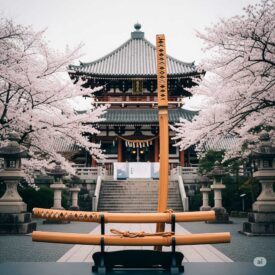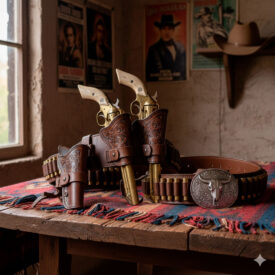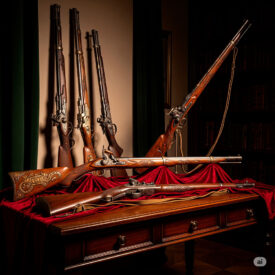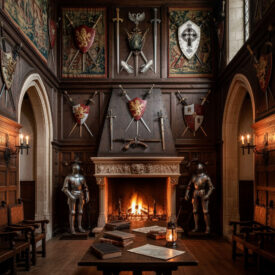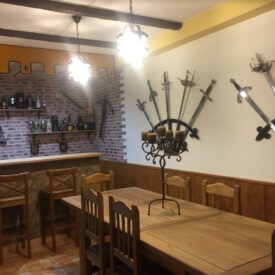A metallic strike in the gloom of a room can become the visual narrative that defines a home: this is how panoplies are born, mural compositions that fuse history, symbolism, and contemporary design to create walls that tell legends.
Why Panoply Decor Continues to Fascinate
Panoplies are not just accessories; they are vertically mounted narratives. Each sword, shield, or banner brings together centuries of tradition and imbues a space with a sense of presence and authority difficult to replicate with ordinary objects. In 2025, when the search for pieces with soul and character is booming, panoplies find their natural place among moldings, wood paneling, and warm palettes.
In this article, you will learn to: identify panoply styles, integrate them according to trends, choose sustainable materials and finishes, and arrange compositions that balance visual impact with acoustic and thermal functionality.
Chronology: Origin and Evolution of the Panoply
Panoplies have roots in antiquity, when weapons and banners served both to intimidate and to narrate. Through the Middle Ages and the Renaissance, these compositions were consolidated as a display of status and military heritage. In the 19th and 20th centuries, the fascination with medieval and exotic elements led to decorative reinterpretations in bourgeois drawing rooms. Today, in the 21st century, the panoply is reinvented: sustainable materials, aged finishes, and curated arrangements allow a traditional piece to coexist with contemporary and biophilic design.
Panoply Styles and Their Visual Impact
Classic Medieval Panoply
Symmetrical compositions with crossed swords, central shields, and ornamental elements. Ideal for spaces seeking a pronounced historical aesthetic without losing elegance.
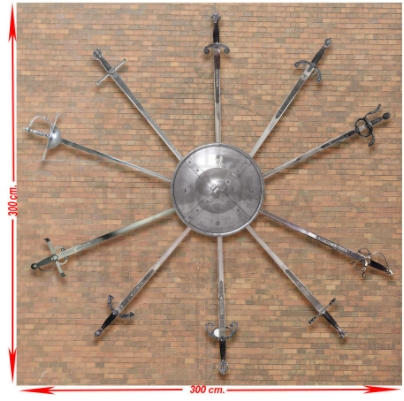
Thematic Panoply (Viking, Templar, Fantasy)
Recreates specific atmospheres: Nordic motifs with axes and rustic tones; Templar panoplies with crosses and tanned leather; fantasy-inspired compositions that integrate iconic pieces for fans of sagas like The Lord of the Rings or Conan.
Modern or Hybrid Panoply
Combines weapons as sculptural elements with contemporary materials: wood paneling, curved moldings, and matte finishes. Favors a less literal and more artistic integration, perfect for living rooms that require dialogue between past and present.
Materials, Finishes, and Sustainability
Choosing materials means deciding the voice of the panoply. Natural wood adds warmth; aged metal gives character; leather and fabrics offer textures that soften the composition. For 2025, prioritize sustainable materials and responsible processes.
- Recycled or certified wood: functions as a support and an aesthetic frame when integrated with paneling or moldings.
- Metals with aged finish: matte brass, patinated iron, or burnished steel for an authentic look without excessive shine.
- Protections and treatments: ecological varnishes and low-toxicity mineral oils to preserve wood and metals.
Practical Conservation Tips
- Humidity control: avoid abrupt changes so that woods and leathers do not deform.
- Gentle cleaning: dry or slightly damp cloths; avoid aggressive chemicals on aged metals.
- Metal maintenance: mineral or camellia oils for pieces that need protection; for exposed fittings, periodic cleaning and protection.
How to Integrate a Panoply According to the Space
Living Room and Fireplace
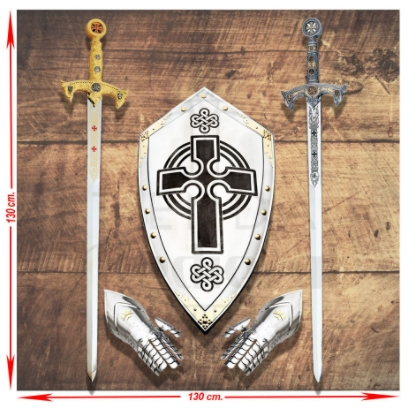 Placing a panoply on or near a fireplace is a classic. The key is scale: the ensemble should not compete with the fireplace but accompany it. Play with moldings and vertical panels to frame the composition.
Placing a panoply on or near a fireplace is a classic. The key is scale: the ensemble should not compete with the fireplace but accompany it. Play with moldings and vertical panels to frame the composition.
Hallway and Corridors
A long corridor accommodates horizontal panoplies or series of small compositions that tell a story as you walk through. In the hallway, a central panoply should be at eye level for immediate impact.
Wine Cellar and Thematic Spaces
The wine cellar is a perfect place for more robust compositions: dark materials, directed lighting, and sturdy pieces work very well.
Integration with Paneling and Moldings
Wood paneling acts as a stage. Using moldings or warm-toned paneling allows the panoply to be perceived as an artistic object integrated into the interior architecture, not as an ornament stuck to the wall.
Lighting: How to Highlight the Composition
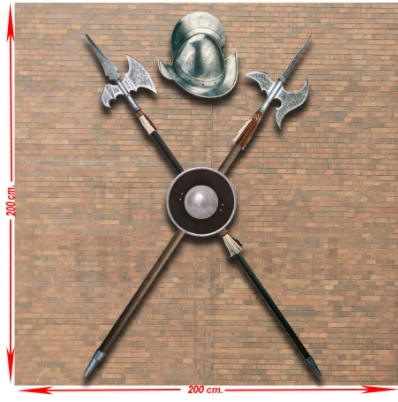 Lighting transforms a panoply from an object to a work of art. Use directional lights, such as recessed spotlights or discreet wall sconces, with a warm temperature (2,700–3,000K) to enhance the metal’s shine without causing annoying reflections.
Lighting transforms a panoply from an object to a work of art. Use directional lights, such as recessed spotlights or discreet wall sconces, with a warm temperature (2,700–3,000K) to enhance the metal’s shine without causing annoying reflections.
- Dimmable spotlights: allow intensity to be adjusted according to time and atmosphere.
- Hidden LED strips: for a soft halo that makes the piece float above the paneling.
Compositions and Proportions: Rules That Work
Work with the rule of thirds: place the focal point (a shield or a central piece) off the geometric center for a more dynamic composition. Alternate vertical and horizontal pieces to generate visual rhythm.
Practical Examples
- Symmetrical panoply: two crossed swords and a central shield for a classic and solemn effect.
- Asymmetrical panoply: a long sword accompanied by small pieces (daggers, pennants) for a more contemporary look.
Secure Mounting and Fasteners
Safety is a priority: use appropriate anchors for the type of wall (brick, drywall, stone). For heavy pieces, use lag screws and chemical anchors if necessary; for light compositions, wide-headed hangers suffice.
- Weight distribution: distribute the weight over several points and avoid hanging the entire load from a single anchor.
- Accessibility: consider access for cleaning and maintenance.
Panoplies and Lifestyles: From Functional to Symbolic
Beyond aesthetics, a panoply can express belonging, hobby, or genealogy. In contemporary environments, it is used as narrative art: each piece adds a layer of meaning that the viewer can interpret.
Designed Panoplies and Ready-Made Packs
If you are looking for ready-to-hang solutions, there are compositions designed to facilitate integration into different spaces, from compact models for hallways to large panoplies for living rooms and wine cellars.
When selecting a ready-made pack, review the materials, finish options, and assembly instructions to ensure the piece fits the architectural context and conservation needs.
Long-Term Maintenance and Storage
To keep a panoply in optimal condition, control light, humidity, and dust. For storage, wrap metallic pieces in acid-free cloths and store leather and wood elements separately to prevent moisture migration.
- Labeling: record dates and treatments applied for future maintenance.
- Periodic inspections: check anchors and fasteners every season.
Integration with Other Pieces and Collections
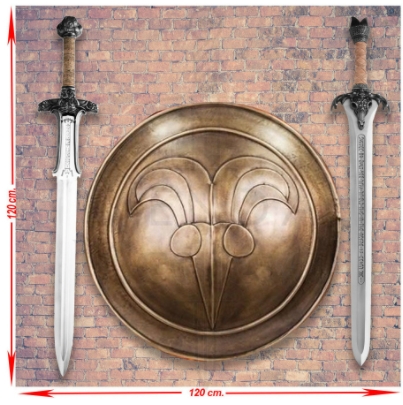 A panoply does not have to be the only piece on the wall. It can be articulated with framed photographs, tapestries, shelves, or display cases containing small replicas, creating a narrative and coherent ensemble.
A panoply does not have to be the only piece on the wall. It can be articulated with framed photographs, tapestries, shelves, or display cases containing small replicas, creating a narrative and coherent ensemble.
Real Cases and Examples of Use
Imagine a reading room with light oak paneling, a curved sofa, and a hybrid panoply above the fireplace. The piece adds drama and context, while the curved lines of the furniture soften the visual hardness of the weapons.
Common Mistakes and How to Avoid Them
- Incorrect scale: hanging an oversized panoply on a small wall can overwhelm the space; calculate proportions before installing.
- Poor contrast: avoid backgrounds that hide details; a neutral paneling or earthy tones enhance the readability of the piece.
- Inadequate fasteners: make sure to use appropriate anchors depending on the wall material.
How to Personalize a Panoply to Tell Your Story
Incorporate objects with personal meaning: an inherited dagger, a replica of a historical sword admired by your family, or textile details with family motifs. Personalization gives the panoply unquestionable symbolic value.
Resources to Learn More and Keep Experimenting
Research armament history, conservation techniques, and artistic composition studies. Participating in historical reenactment forums or collector groups can offer valuable practical and aesthetic perspectives.
Resolve Your Doubts About 2025 Decoration Trends
What natural and sustainable materials are gaining popularity in 2025 decoration?
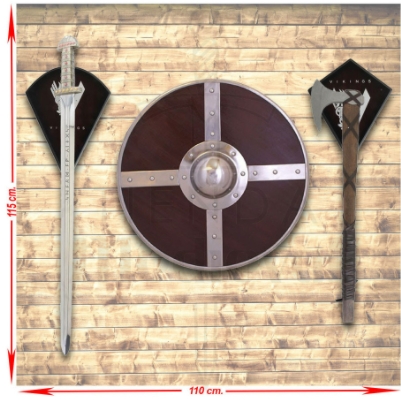 The natural and sustainable materials gaining popularity in decoration for 2025 are primarily untreated and recycled wood, stone, linen, bamboo, natural fibers like jute and hemp, vegetable-tanned and natural leather, ceramics, jesmonite, and soy wax. Also noteworthy is the use of artisan fabrics, organic cotton, ecological microcement with a low carbon footprint, and non-toxic mineral finishes. These materials provide warmth, authenticity, and align with environmental commitment, in addition to requiring specific care to maintain their properties.
The natural and sustainable materials gaining popularity in decoration for 2025 are primarily untreated and recycled wood, stone, linen, bamboo, natural fibers like jute and hemp, vegetable-tanned and natural leather, ceramics, jesmonite, and soy wax. Also noteworthy is the use of artisan fabrics, organic cotton, ecological microcement with a low carbon footprint, and non-toxic mineral finishes. These materials provide warmth, authenticity, and align with environmental commitment, in addition to requiring specific care to maintain their properties.
Overall, this trend reflects a return to nature and craftsmanship, with an aesthetic that seeks simplicity, serenity, and connection with the environment through earthy and organic colors that complement these materials.
How are curved lines integrated into interior design for 2025?
Curved lines in interior design for 2025 are integrated through soft, rounded, and organic shapes that replace rigid straight lines, providing warmth, movement, and a sense of fluidity and comfort in spaces. These curves manifest in furniture such as sofas and tables with rounded edges, architectural elements like minimalist moldings, walls, columns, and corners with sinuous shapes, generating cozy, elegant, and balanced environments that promote well-being and a visual connection with nature. This approach seeks to create unique, harmonious, and sophisticated spaces that are also functional and visually lightweight.
What role do moldings and wood paneling play in current decoration?
Moldings and wood paneling play a fundamental role in current decoration by bringing elegance, warmth, and sophistication to spaces, combining classic styles with modern trends. Moldings allow walls and frames to be enhanced with details that provide a distinctive and timeless touch, while paneling not only beautifies but also improves the acoustic and visual comfort of the environment. In addition, wood is used both on large surfaces and in details to create contrasts and textures that enrich the aesthetic without overloading the decoration. The use of sustainable and recycled woods also reflects a growing concern for ecology within modern trends. In summary, these wood elements contribute to creating cozy, elegant, and versatile environments, adapting to styles ranging from minimalist to traditional.
What are the decoration trends for open spaces in 2025?
The decoration trends for open spaces in 2025 mainly focus on the visual and functional integration of the exterior with the interior, biophilia, and sober luxury with natural materials and technology. Key points are:
- Indoor-outdoor integration to create a continuous visual and functional flow between both spaces.
- Use of native plants in large pots and vertical gardens as living elements that provide freshness and serve as natural barriers against wind and sun.
- Ecological and natural materials such as stone, artisan ceramics, wood (ideally second-hand), blown glass, with decorative elements that include shells, logs, and decorative stones for a sophisticated and cozy style.
- Smart sun protection with bioclimatic or retractable pergolas and manual parasols, seeking chromatic harmony with the furniture.
- Saturated and organic colors such as deep greens, intense blues, and browns, along with curvilinear and textured shapes in furniture and decoration.
- A trend towards silent and experiential luxury, with noble materials, discreetly integrated technology, and a focus on personal well-being in the outdoor space.
- Predominance of a design that emphasizes the biophilic ethos, merging architecture and nature to blur the boundaries between inside and outside, creating a natural and personal sanctuary outdoors.
- Other elements to highlight outdoors are modern wicker furniture, cold water pools, outdoor kitchens, green roofs, and adaptations for natural disasters.
In summary, 2025 consolidates outdoor decoration as a vital and personal space, with a natural, functional, and technologically advanced aesthetic, always prioritizing connection with nature and refined comfort.
What natural colors and tones are predominating in interior decoration for 2025?
The predominant natural colors and tones in interior decoration for 2025 are organic and earthy tones, especially moss green, olive green, terracottas, beiges, sands, and chocolate browns. In addition, deep blues with greenish nuances, such as ocean blue, stand out. These colors are combined with natural materials and textures such as light wood, linen, stone, and terracotta to create cozy, relaxed environments with a connection to nature. Sustainability and biophilia influence these trends, which seek to evoke tranquility and authenticity in interior spaces. Contrasting touches, such as gold details or vibrant colors, are also used to complement these natural palettes.
| Type of oil | Main characteristics | Recommended use |
|---|---|---|
| Mineral oil | High penetration, does not degrade or attract dirt | Regular protection and maintenance |
| Camellia oil | Natural, acid-free, non-volatile | Antioxidant protection, lubrication |
| Lithium grease | Dense, durable, does not evaporate | Extended storage, protection |
- Mineral oil
-
- Main characteristics: High penetration, does not degrade or attract dirt
- Recommended use: Regular protection and maintenance
- Camellia oil
-
- Main characteristics: Natural, acid-free, non-volatile
- Recommended use: Antioxidant protection, lubrication
- Lithium grease
-
- Main characteristics: Dense, durable, does not evaporate
- Recommended use: Extended storage, protection
Panoplies, Creativity, and Community
The historical reenactment and collecting community has transformed functional pieces into cult objects. Sharing photos, participating in fairs, or collaborating with artisans allows each panoply to evolve and take on new meanings.
VIEW MORE DESIGNED PANOPLIES IN YOUR MEDIEVAL-SHOP | VIEW OTHER PANOPLIES | VIEW OTHER BEAUTIFUL MEDIEVAL DECORATION
Ultimately, the panoply is a bridge between eras: a work that speaks of battles, rituals, and aesthetics. With criteria and care, you can turn a wall into a stage where past and present dialogue, creating a unique space that inspires stories daily.

